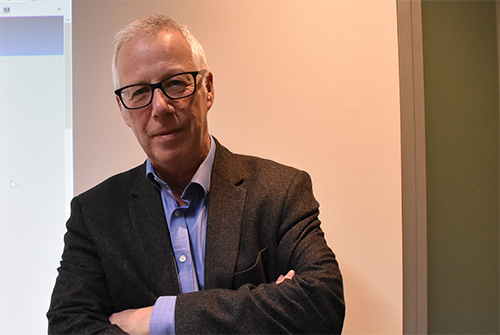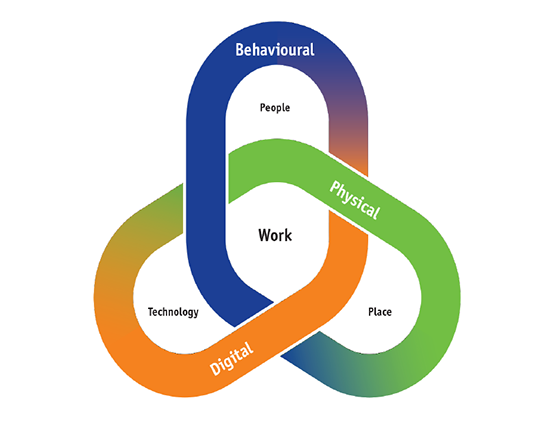Designing for a More Diverse Workforce--An interview with Mr. Jeremy Myerson
Jeremy Myerson / Director of the WORKTECH Academy & Research, Professor at the Royal College of Art
In Japan, which has entered a super-aging society ahead of other developed nations, how should we consider the office, where a diversity of people including older people will work? We asked Mr. Jeremy Myerson, Director of WORKTECH Academy & Research in the UK, on the theme, "designing for a more diverse workforce."

Related article:The global trend of offices is becoming more "human-focused"--A report on WORKTECH 2018 Tokyo
Workplaces are required to change
Expectations toward offices have been rising in recent years. This is because the concept of the workplace has not changed since the times of factory work, although the majority of work that are done in offices have become knowledge work since the 2000s. Workplaces based on factory work where you would control workers by putting them in cages still exist, causing a mismatch between the type of work we do and the type of settings of work. Workplaces must change to embrace knowledge work.
Process-based factory work valued how many of the same item can be made every day, but for knowledge workers, no two days that you have ever repeats itself exactly. Values such as social relationships, collaboration and network have become more important. An example is the type of work where you learn from the experience of your previous job and create innovation from new encounters.
In the 1980s, innovations by Japanese companies led the world. In those days, innovation was all about manufacturing, and the whole world learned from Toyota, for example. Now in the digital and knowledge economy, Japan is lagging behind in innovation. It is challenging times.
Another reason why the workplace must change is the diversity of the workforce. In the UK, for example, the majority of office workers used to be healthy, white male until the middle of the twentieth century. But now, women, older people and people with disabilities work in the same place. What kind of office should be designed for the new workforce? It is difficult to satisfy such a diversity of people, but we must think about it.
Japan, in particular, has entered a super-aging society ahead of other developed countries. Millennials are becoming the focus of attention in the global work scene, but older people are also required to continue knowledge work longer in order to maintain the economy. To create an environment where everyone can work in health both mentally and physically is not just an issue for Japan but a universal one.
Four factors that shape the future workplace
Through our various studies,*we found four factors that influence work. They are control, messaging, alignment and refresh. It would be worthwhile to be aware of these four factors when companies think of their future office.
*Source:Research Design Connections /WORKTECH Academy
1)Control:Giving a person a sense of control over their work
The most important factor is control. This does not mean the control of an organization over its workers. It means whether the workers themselves have control over the environment in which they work. In an experiment carried out by psychologist Dr. Craig Knight, the subjects made less mistakes and showed greater productivity in clerical work in an environment where the subjects could decorate the office as they liked rather than in a lavish office setting.
For example, it is important to give workers choice in terms of air conditioning, lighting, the desk height, the type of chair, and where in the office they want to work. There still are probably many offices that do not offer choices to users, requiring them to withstand heat or work in a chair even if they wanted to work standing.
Furthermore, having a sense that one has control not only over the workplace but everything surrounding work, such as work hours, the type of work, the method of commute, commute time and work-life balance, is extremely important from the perspective of well-being and productivity. That said, we have also found in our studies that giving workers too much control is not good either, so it will be necessary to seek the best balance for the organization.
Workers should be able to have an even greater sense of control over their work when solutions such as RPA and chat bots are introduced in the future, reducing tedious tasks such as room booking and allowing workers to devote their energy on their core work. This is very exciting. Therefore, I think technologies like AI, RPA and IoT should be introduced to workplaces more and more.
2)Messaging:Offices that send out a message from the company to workers
All workplaces send a message from the organization to the worker. Not only are good messages sent out from good offices, but not thinking about the office and not taking any measures will also be sent out as a negative message. In other words, offices non-verbally communicate an organization's attitude and culture of how it intends to treat its workers.
A fairly clear-cut message sent out by a workplace is comfort. There are three levels of comfort that are required of an office. The first is physical comfort. This is influenced by temperature, humidity, lightness and sound. The second level is functional comfort. This is the realm of a designer, such as keeping the PC screen free of glare and giving workers a comfortable, ergonomic chair.
As these two levels involve hardware, they can be dealt with relatively easily and the reactions of the workers are also clear. The most difficult level is the third level--psychological comfort. For example, an office that fosters a sense of belonging and ownership or an office which workers feel is their own territory would be psychologically comfortable.
It is harder to design this element as it is intangible and the effects are difficult to grasp, but I think it is an issue that companies must tackle in the future. This is not only because it is important to increase physical and functional comfort, which has an effect on individuals, but also because an office that fosters a sense of belonging and ownership improves the comfort of the team. As the importance of communication and collaboration in work increases, I think that these messages are becoming very important.
3)Alignment:Balancing the different needs of the company and the individual
Aligning the needs of the company and the needs of the worker, which are inherently conflicting, is also an important role of the workplace. One of the ways to do this is to provide healthy food and drinks, for example.
What is important here is that the company not just provides food but that it also selects healthy food. As can be said with messaging, having these intentions will bring out workers' sense of belonging and trust in the company.
Recently there has been a rise in companies providing workplaces where the workers can feel nature, such as terraces and rooftop gardens. These initiatives are also very effective for alignment. The desire to feel nature is a very personal need of workers and will conflict with, as does healthy food, the need of companies, which is to make a profit. However, if workers' performance improves by providing them with a workplace that satisfies their needs, the company's needs will also be satisfied as a result. In this way, the office can bridge the needs of both parties.
4)Refresh:Improving the quality of the three Cs (concentration, collaboration and contemplation) by refreshing
For a workplace to improve the quality of knowledge work, it needs spaces that are dedicated to the three Cs (concentration, collaboration and contemplation). Specific examples are as follows:
(1) Concentration: A space for scrutinizing data and focused analysis. It is equipped with task lights, motorized height adjustable desks, an audio-masking system and window views, for example.
(2) Collaboration:A space owned by a team for sharing data and harnessing the potential. It is equipped with display media, bench style tables and dynamic lighting.
(3) Contemplation:A space for contemplating by shunning data and escaping from the digital. It is a private space equipped with a gardening facility, a curtain of falling water and ergonomic furniture.
The importance of refresh, which enables these spaces to function well, has been rising in recent years on the back of the diversification and aging of knowledge workers.
Knowledge work is very tiring. Because people cannot maintain a high level of work momentum all the while they are at the office, they need to have time to refresh and relax. Going forward, it will be particularly important for workers not just to rest but to recover both physically and mentally and reboot in order to stay in work for longer in a super-aging society.
Future knowledge workers will probably embrace a workstyle in which they will balance "concentration, collaboration and contemplation" and "refresh and relax." Workplaces will obviously have to be able to support such workstyles.
Conclusion

In considering the future office, we must integrate people (HR), technology (IT) and place (FM (Facility Management)), which had been functioning separately, and think of the office as a seamless continuum. If you bear in mind the four factors mentioned earlier, you will know that all functions must be coordinated.
It would be good if Japan could set an example as a front runner of a super-aging society. The problem that Japanese companies face is their legacy of hierarchical command-and-control structures and a unique way of doing things. However, there should be enough grounds for them to show a high level of performance on a global scale and maintain their uniqueness at the same time. I am looking forward to their efforts.
Director of the WORKTECH Academy & Research, Professor at the Royal College of ArtJeremy Myerson is an academic researcher, author and activist in people-centred design and innovation. He has joined Unwired to set up The WORKTECH Academy, a global knowledge network. He has published several influential books on workplace design and holds the Helen Hamlyn Chair of Design at the Royal College of Art, London. His most recent titles include Time & Motion (2013) and Life of Work (2014). A former journalist and editor on such titles as Design, Creative Review and World Architecture, he founded Design Week magazine in 1986 and later co-founded the Helen Hamlyn Centre for Design at the RCA in 1999, which he directed for 16 years until September 2015. He has advised businesses and governments around the world and sits on the advisory boards of design institutes in Korea, Switzerland, and Hong Kong. He was recently named by Wired magazine as one of Britain's 100 most influential people in digital technology.